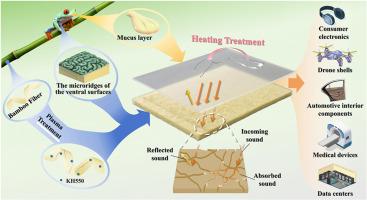Plasma-textured bamboo metamaterials with tree frog-inspired hierarchical topography and self-healing interface for synergistic acoustics
IF 9.8
1区 材料科学
Q1 MATERIALS SCIENCE, COMPOSITES
引用次数: 0
Abstract
Natural bamboo fiber (BF) composites offer a sustainable alternative to non-biodegradable synthetic polymers (e.g., polypropylene, PP) in noise control, yet face dual challenges: disordered surface morphology limits acoustic energy conversion, and weak fiber-matrix interfacial bonding induces performance degradation. Inspired by the multi-scale sound-dissipation architecture of tree frog skin (micro-papillae attenuating 3000–5000 Hz noise and nanofolds reducing reflectivity by 62 %), we propose a cross-scale synergistic strategy integrating plasma-induced surface reconstruction (300W/180s/O2) and covalent-supramolecular dual-network (DCN-PEI) interfacial engineering. Plasma treatment constructs “groove-particle” hierarchical structures (groove depth: 1.2 ± 0.3 μm, particle diameter: 80 ± 20 nm), while KH550 silanization forms Si–O–C bonds increasing the contact angle to 111.1° ± 2.3°, mimicking the hydrophobic barrier function of glycoprotein mucus. The biomimetic composite achieves: 1) Record-high sound absorption coefficient (SAC) (α = 0.82 ± 0.03 at 2000–4000 Hz, 35 % enhancement vs. untreated BF); 2) Ultrahigh transmission loss (>55 dB at 1000–6300 Hz, thickness: 6 mm, density: 0.5 g/cm3), outperforming palm fiber by 42 % in SAC and commercial PP board by 2.6-fold in noise reduction (29.6 dB vs. 11.6 dB); 3) Self-healing functionality with 34 % ± 3 % scratch depth recovery via dynamic H-bonds and transesterification. This work pioneers cross-scale integration of biological acoustic mechanisms and self-repair, establishing a “morphology-interface-function” trilevel design paradigm for sustainable acoustics.

等离子体纹理的竹子超材料,具有树蛙启发的分层地形和自修复界面,用于协同声学
天然竹纤维(BF)复合材料在噪声控制方面是不可生物降解合成聚合物(如聚丙烯、PP)的可持续替代品,但面临双重挑战:无序的表面形态限制了声能转换,纤维-基质界面结合薄弱导致性能下降。受树蛙皮肤多尺度消声结构(微乳头可衰减3000 - 5000hz噪声,纳米折叠可降低62%的反射率)的启发,我们提出了一种结合等离子体诱导表面重建(300W/180s/O2)和共价-超分子双网络(DCN-PEI)界面工程的跨尺度协同策略。等离子体处理形成“凹槽-颗粒”层次结构(凹槽深度为1.2±0.3 μm,颗粒直径为80±20 nm),而KH550硅烷化形成Si-O-C键,使接触角增加到111.1°±2.3°,模拟糖蛋白黏液的疏水屏障功能。仿生复合材料取得了:1)创纪录的吸声系数(SAC) (2000-4000 Hz时α = 0.82±0.03,较未处理BF提高35%);2)超高传输损耗(1000-6300 Hz时55db,厚度:6 mm,密度:0.5 g/cm3), SAC性能优于棕榈纤维42%,商用PP板降噪性能优于2.6倍(29.6 dB vs 11.6 dB);3)通过动态氢键和酯交换反应,具有34%±3%划痕深度恢复的自愈功能。这项工作开创了生物声学机制和自我修复的跨尺度整合,建立了可持续声学的“形态-界面-功能”三级设计范式。
本文章由计算机程序翻译,如有差异,请以英文原文为准。
求助全文
约1分钟内获得全文
求助全文
来源期刊

Composites Science and Technology
工程技术-材料科学:复合
CiteScore
16.20
自引率
9.90%
发文量
611
审稿时长
33 days
期刊介绍:
Composites Science and Technology publishes refereed original articles on the fundamental and applied science of engineering composites. The focus of this journal is on polymeric matrix composites with reinforcements/fillers ranging from nano- to macro-scale. CSTE encourages manuscripts reporting unique, innovative contributions to the physics, chemistry, materials science and applied mechanics aspects of advanced composites.
Besides traditional fiber reinforced composites, novel composites with significant potential for engineering applications are encouraged.
 求助内容:
求助内容: 应助结果提醒方式:
应助结果提醒方式:


